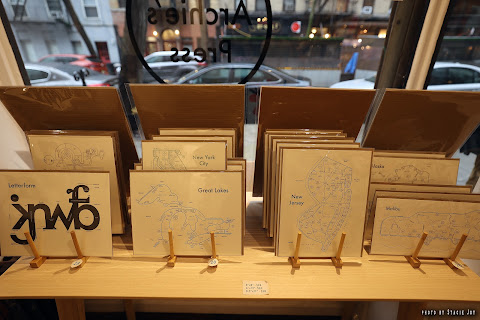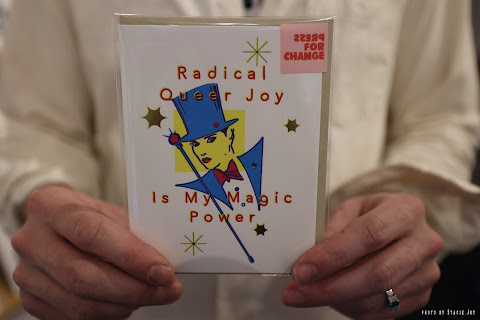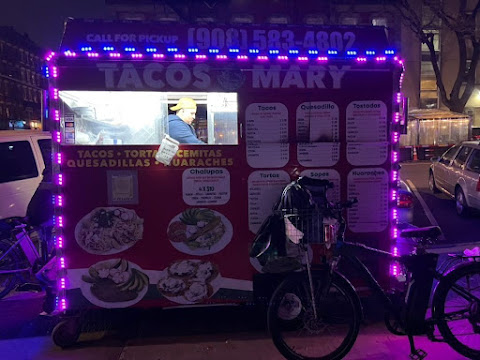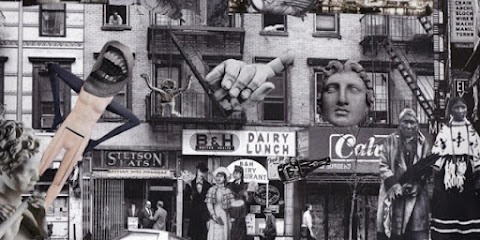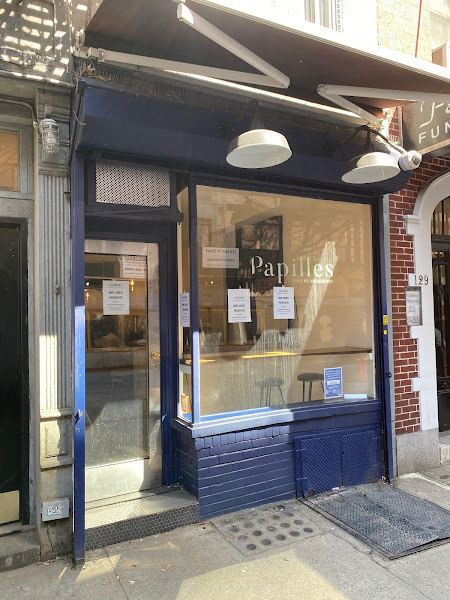Friday, March 18, 2022
Friday's parting shots
Steven shared these photos of the crocus popping up in Tompkins Square Park today... near the entrance at Seventh Street and Avenue B...
Sweetness and light
Blushing was a standout band from last week's New Colossus Festival — playing five showcases, including a shoegaze extravaganza at Arlene's Grocery... the Austin, Texas-based quartet recruited shoegaze legend Miki Berenyi from Lush for this single, "Blame."
CB3's full board meeting in March will be virtual
In case you had plans to attend CB3's full board meeting this coming Tuesday (March 22) evening at 6:30 ...
Gov. Hochul has extended the state of emergency and suspended the Open Meeting Law until April 15.
EVG Etc.: The continued support for Veselka; the history of The Portable Lower East Side
New art on AvenueA by Winston Tseng (background)
• More on the overhwhelming support for Veselka (CBS News)
• EV bars The Gray Mare, Slainté and Cooper's Craft + Cocktails are hosting happy hours in support of Ukraine today, March 18, from 4-7 p.m. (Pursuitist)
• Lawsuit alleges that upstate woman was swindled out of $160,000 by psychics on Avenue A (The Post)
• Kurt Hollander on publishing The Portable Lower East Side (1983-1993). Back issues are now on sale at Printed Matter on St. Mark's Place and Second Avenue (Literary Hub)
• A feature on the vintage shop Cobblestones on Ninth Street (CBS 2)
• Details on La MaMa Moves! Dance Festival, back next month for its 17th annual edition (The Lo-Down)
• Inside an East Village brownstone "where every floor encourages a different energy" (domino)
• A tour of the recently opened Bronx Brewery on Second Avenue (Untapped Cities ... previously on EVG)
• Art by Anna Sorokin among the work featured in a group show, titled "Free Anna Delvey," at 176 Delancey St. through March 24 (The Art Newspaper ... The Daily Beast)
Gallery Watch: Emily Oliveira at Geary on the Bowery
Interview by Clare Gemima
Photos courtesy of Geary
Captivated by the Brooklyn-based Emily Oliveira’s bold and saturated exhibition, I was lucky enough to speak to Geary’s gallery director Poppy DeltaDawn about “Red Velvet, Orange Crush.” The show in the gallery at 208 Bowery is packed with color, varying mediums and an innumerable amount of fascinating visualizations.
In an attempt to understand more about the artist’s process and broader practice, I reached out to Emily to ask about their research, studio time and exciting plans for the future.
As soon as you walk into Geary’s building, a painted orange and yellow, to blue and purple gradient covers the walls from floor to ceiling. Can you explain the intention behind transforming the gallery so boldly, and speak to how it affects the position of each of your works?
I wanted to give the viewer the feeling of standing on the precipice of something, possibly gazing at a light or a portal opening up onto another world. The colors in the gradient are also ones that are found together at sunset or sunrise, when our pupils are dilated and our eyes are starved for light, which heightens that sensory experience of color, of being at the threshold of something shifting and changing as you look at it.
One of my favorite things about the way we painted the space is that the gradient is built out of translucent layers of color — your eyes don’t stop at a flat color the way they do on most painted walls. Light passes through the layers of color and increases the feeling that the surfaces you’re looking at are in flux somehow.
The quilts in your show are all different shapes and sizes, some ovular and some more circular. There is even one that appears more “eyelid” in shape. Is this aspect something you pre-plan in your studio, or is it something that occurs accidentally?
I started to play around with the shape of my quilts last spring, and since then I’ve realized that the impulse toward a curved or oblong shape has to do with making the viewer aware of the earth in space, and the picture plane of the quilt recalling vision more that it recalls an interior window or a framed painting. I tend to plan these shapes in my sketchbook, but I also try to respond to the materials as much as possible in the studio and do not try to make the fabric do things that it doesn’t want to do. I respond to the ways that it wants to pucker or drape.
Poppy, Geary’s gallery director, mentioned you have an interest and knowledge in the concept of hydromancy, a ritualistic practice that channels signs and warnings from water. Can you elaborate on how this idea inspired “Listening Bowl with Two Figures” (2021) and “Listening Bowl with Reclining Figure” (2021)?
I started making those small sculptures after a show last year when I wanted a little break from making quilts, and I thought about them immediately as vessels and tools for hydromancy. I think the idea of hydromancy relates to the gradient on the walls, and the water and the portals depicted in the quilts — a vision of something just beyond our reality appearing momentarily in a shifting liquid.
Speaking to notions of tradition and folklore, one of your quilts depicts the resurrection of an ox, which presumably references Brazil’s famous yearly celebration, Bumba Meu Boi, or perhaps the story behind it. Have you ever participated in its traditions outside of your immediate art-making?
I am interested in the idea of an ox shared by a community as a collectivist symbol, and its resurrection as a way of talking about the resiliency of leftist movements in Latin America. My connection to Bumba Meu Boi is primarily through heritage, the objects created for use in the performance, and an ongoing interest in the emancipatory potential of participatory performance.
Was it more human, animal or other that inspired the creation of “I am weak with much giving, I am weak with the desire to give more” (2022)? And, what soft or hard sculpture artists do you gravitate toward in your research?
I’m very influenced by practical effects (puppetry, miniatures, animatronics) in science fiction and horror movies from the 1970s-90s, and particularly that their general disappearance from film has nothing to do with obsolescence and everything to do with labor (workers in CGI are not unionized but fabricators and designers of practical effects are).
The film influences on this particular sculpture are “Species,” “Alien” and “Jumanji,” with the horror of the first two based in the monstrous feminine, and the last one the colonial trope of the “hungry jungle” — two concepts pretty near and dear to my practice.
So, as a roundabout way of answering your question, I’m interested in taking the horror associated from the blurring of boundaries between the “human, animal, or other” and turning it inside out, and hopefully into something tantalizing, erotic and post-human.
The writer for your catalog, Kyle Dacuyan, claims that visual mythologies, ecological considerations and the cosmos are all areas that “Red Velvet, Orange Crush” explore. They also poetically write that the work rides on reverie. Do you feel as though all of your work deals with sentiments that Dacuyan describes? And, will you adopt this vernacular moving forward with your artistic practice?
I’ve been working with interlocking mythological and science fiction narratives in my work for several years now, and the work is invariably informed by present ecological collapse. The cosmos comes into play in a way that relates to your question about the shape of the textiles — trying to call attention to our own subjectivity and that we are caught between two parentheses: a living earth and an infinite cosmos.
You’ve used processes such as hand-dying, sewing, stitching and cyanotype. You have also used silks, velvets, linens and sequins, to name a few of your materials. While making the work for the show, what process or materials did you struggle with the most, and how long — roughly — did “Red Velvet, Orange Crush” take until it was ready to hang as a show?
All of the work for the show came together in a little less than a year. I think I continue to struggle the most with time and the time-consuming process of appliqué and quilting. Hand dyeing is a fast and loose process that requires a lot of preparation and a lot of steps, but I really enjoy all of the different processes that my studio practice allows me to engage in. I think if I was only doing one process every day I would not feel as excited to go to the studio.
Is there anything extremely important to know before a viewer sees your work for the first time in person?
I think other than knowing that the works in the show are all handmade textiles (with the exception of the two small paper pulp sculptures on the mantle), I ideally would want the viewer to have an unmediated sensory experience of the work! I also think the work and the painting on the wall are particularly beautiful in the daytime, with sunlight coming in from the windows.
What do you hope to focus on after you have finished your studies? What do you have in store exhibition/show wise?
After I graduate in 2023, I’m going to be in Rome for a year at the British School at Rome, which I’m really thankful and excited for. Right now I have a mural that’s at the Lena Horne Bandshell in Prospect Park until early May, and in the fall, I’m going to have another solo exhibition at LaMama Galleria that’s opening in September 2022.
I’ll also have my thesis exhibition sometime next year, both in New Haven and at a space in New York. I’m excited to continue exploring textiles and expanding my practice. I also want to continue exploring videos and performances that have been set aside for a while since I’ve been in school.
~~~~~~
Clare Gemima is a visual artist and arts writer from New Zealand, now based in the East Village of New York. You can find her work here: claregemima.com
Thursday, March 17, 2022
A visit to Archie's Press on 10th Street
Text and photos by Stacie Joy
I’m eager to meet Archie Archambault, the mind behind Archie’s Press, a newly opened letterpress-printed retail art and map shop at 219 E. 10th St between First Avenue and Second Avenue.
An East Village resident as well, Archie greets me at the shop before business hours, shows me the prints, maps, and pressed art pieces, and patiently answers my questions about the letterpress machine and process, his conception and design methods, and what’s it’s been like opening a retail space during the pandemic.
Can you provide a brief primer on letterpress — including the part about potentially crushing every bone in your hand?
Between 1492-1980, anything printed for mass consumption was produced using letterpress technology. Every size of every font was cast in little metal letters that were strung together and printed into advertisements, newspapers, books…everything. For disseminating information, this was the most important technological development until the internet.
EV Grieve would be typeset by hand if it was around in the 1970s. [Ed note: YES!]
Digital typesetting made it mostly obsolete and many presses were left to rot or destroyed. In the late 1990s, people started rehabbing presses to make beautiful stationery and art books. Letterpress actually presses the design into the paper, leaving a strong indentation. It’s up to 600 pounds of pressure, which can easily crush every bone in your hand — watch out!
How did your interest in letterpress come about?
I took a letterpress course in college and got hooked. I’m not sure exactly why. It’s a very “liberal arts” craft. It’s composed of words, so you become a poet. The type needs to be laid out so you become a designer. The colors need to be mixed, so you become an artist. The press is going to break, so you become a mechanic.
There are so many different parts of the brain at work when executing a project. I’m impatient, so it forces me to slow down, think carefully, and stay cool when things don’t go smoothly. When I started selling my work, it became my full-time job, and I haven’t looked back.
Please tell us a little about the Vandercook SP-15 that you use in the shop.
This model is the lightest flatbed press available at about 700 pounds. It was designed to make one perfect copy of something like a newspaper sheet using hand-set type. That one perfect copy would be made into a film for offset printing, which runs very quickly (it’s the machine you see in old movies during newspaper montages).
Remember, there were no computers, so this was the only way to get that one perfect copy. Vandercooks are the most common flatbed presses for doing larger letterpress prints because they are reliable and bulletproof. My press operates without a motor, so it can be used during the apocalypse, which is exciting.
What’s the concept behind your city/state maps?
New research indicates we’re underutilizing the navigational parts of our brains because of GPS. Turns out that’s a problem. This is a hugely powerful part of our brains. When was the last time you felt so lost you thought, “uh oh?” Google Maps is constantly coming to the rescue.
I’m trying to explain the city in the major gestural terms on a map that taps into the “map from the mind.” There’s a great book called “Image of the City” by Kevin Lynch that describes our mind’s vision of our urban spaces. We do not think in birds-eye view. We create our mind’s map with pathways, boundaries, landmarks, nodes and neighborhoods.
I try to draw a map that brings all these things together and omits everything else. I want the viewer to engage with the map and feel the city when they explore it. Keeping it simple prevents a “dazzle” effect. Making it beautiful encourages more engagement.
To get to that sharp gestural drawing, I work with people who are from the city to arrange it like it is in their minds. States are much larger areas, which are harder to wrap one’s head around, but still, there are important roads and landmarks in states that keep our minds constantly orienting themselves.
What design vision guides your work?
I have no formal graphic design education, but letterpress is essentially the foundation of graphic design. All the physical rules of letterpress created the visual language we take for granted on our screens. There’s a reason we keep lines evenly spaced. The personality of each font is much louder when it’s cast in metal.
Everything I know about design I learned by typesetting and printing. I do most of my designing on the computer now because it’s so much more efficient, but the vision comes from letterpress. I’ve expanded to many other ideas, all based on organizing information in a way that is simple and beautiful.
Why decide to open a storefront for your products — instead of relying solely on an online operation?
I opened the store for a few reasons: I wanted to start making new work and get people’s reactions right away. Now I can get something from the idea to the shelf within a week rather than months.
After an isolating 18 months due to COVID, I really wanted to see more people and rejoin the community. I live nearby, and I’ve never felt more at home. And I wanted to collaborate with artists and designers, and having a storefront gives me the venue to produce and celebrate their work.
What has been the reaction to the shop so far?
Everyone who comes in is supportive and delighted. Most people who come immediately go for the print racks, flip through every print and then stare at the walls for a while. It’s a feast and everything in the shop is special for one reason or another. I love it when people ask, “Did you make everything in here?” If I did, I would be a wizard.
Why choose the East Village for your shop?
I’ve lived in the neighborhood for five years and love our robust ecosystem of small unique businesses. For some reason, I felt like the East Village would “get it” and appreciate it. I was right! I cannot imagine this shop anywhere else.
Any future plans you care to share?
We’re just starting to take custom print jobs, so if you have a wedding invitation or business cards to get letterpress printed, we’re the place! We’re also starting to collaborate with artists and designers, so we’ll be having a new show every month or two starting in the spring.
You can keep an eye on the presses here.
Store hours:
Monday 1-6 p.m.
Tuesday Closed
Wednesday Closed
Thursday-Friday 1-6 p.m.
Saturday-Sunday noon- 6 p.m.
Gaia Italian Café Shop is coming to the East Village
Photos by Stacie Joy
Coming soon signage is up at 226 E. Third St. between Avenue B and Avenue C... for, presumably, what will be a takeout space/shop for Gaia and a home base for the online business...
After nine years, Gaia Bagnasacco closed her popular business on July 26, 2020, at 251 E. Houston St. between Norfolk and Suffolk.
Bagnasacco then created her pasta, meal kits, and sauces that she sold via an online shop, all available for local delivery, from a space on the LES.
There's no word just yet on an opening date for Third Street. You can follow the Gaia Instagram account for updates ... and order food for delivery here.
H/T Krikor Daglian
Previously on EV Grieve:
The taco cart is BACK on 2nd Street and Avenue A
After missing in action for about six weeks, the taco cart is back on Avenue A and Second Street.
OK, it's actually a different cart with a new name — Tacos Mary now (Tacos Cholula before).
However, an EVG reader who shared the photo here from Tuesday night says the workers are the same. Apparently, this operation is related to the Tacos Mary out in Queens.
Also! A reliable source tells us that the fruit vendor will be back soon on Sixth Street and First Avenue. Also, MIA these past few weeks.
Wednesday, March 16, 2022
Report: Relief supplies for Ukraine stolen from 2nd Avenue nonprofit
Updated 3/19: The Post published a surveillance video showing two vans and masked thieves taking boxes from the building.
The supplies, including 400 bulletproof vests, were taken from the offices of the Ukrainian Congress Committee of America and the Ukrainian National Women's League of America on Second Avenue between 12th Street and 13th Street.
Police responded around 9:15 a.m. to a call of a burglary, the Associated Press reported.
Per the AP via ABC 7:
Andrij Dobriansky, a spokesperson for the Ukrainian Congress Committee of America, said last week that the plan was for donated gear to be shipped by air to Poland and then transported into Ukraine.The items were most likely to be used by civilian security and medical teams, including citizens who have joined the fight against the Russian military, not Ukrainian soldiers themselves, officials said.
The Post noted that the used vests were donated by the Suffolk County Sheriff's Office. Officials there were working to confirm the report.
Cooper Union: Longtime Stuyvesant Street businesses 'informed us of their decision to vacate the property'
Photo from March 11 by Steven
Cooper Union, the landlord of four popular businesses along Stuyvesant Street between Ninth Street and Third Avenue, says the tenants have "informed us of their decision to vacate the property." The landlord also said the tenants haven't paid any rent since 2020.
Yesterday afternoon, school officials responded to reports that the tenants — Angel's Share, Village Yokocho, Panya Bakery and Sunrise Mart, all operated by Yoshida Restaurant Group — were involved in a rent dispute, that the long-term leases were set to expire at the end of the month.
The story began this past Wednesday night when a server at Village Yokocho told a customer, and New York Times correspondent Alex Vadukul, they were closing "due to [a] massive rent hike." Vadukul, a gifted reporter, recounted what he heard from staff in a series of tweets that sparked several follow-up stories, including at Grub Street and Gothamist (and EVG).
In a statement to EVG, a Cooper Union spokesperson provided the following:
Unfortunately, the tenant informed us of their decision to vacate the property. They were not asked to move out, despite the fact that they haven't paid any rent since 2020.Additionally, we offer clarification of a few facts here:• The formula for calculating rent on these properties has been in place for some 30 years and has never been changed.• While the tenants of these properties have not made any rent payments since 2020, they have continued operations in these spaces. We have repeatedly sought to arrive at a good-faith agreement.• Lastly, for context, we should note that The Cooper Union is midway through a 10-year plan to return to full-tuition scholarships for all undergraduates. These properties help to generate revenue for student scholarships.
It's not immediately clear if any of the businesses will relocate (several workers said this in previous reports). A bartender told this to Grub Street's Chris Crowley late last week: "There's an 85 percent chance that we close. It's okay, though, because we're gonna relocate."
Yoshida Restaurant Group has not publically commented on future plans for these businesses.
This corridor has been called a micro-center of Japanese culture. Angel's Share, the speakeasy-style bar, opened here in 1994, with Panya arriving next door in the same year. Sunrise Mart debuted in 1995. There are now also locations in Soho, Midtown and Brooklyn.
Cooper Union did not respond to a follow-up email about what might be next for these retail spaces.
Updated 3/17: The Cooper Union spokesperson said that the school had no new plans for a new building here.
Labels:
Angel's Share,
Cooper Union,
Stuyvesant Street,
Sunrise Market
A broken gate at 89 1st Ave., where permits are still pending for a new building
Photos by Steven
Aside from the broken gate and new tags on the neighboring walls, not much seems to be happening here. Our last post on the property came on Sept. 1. Late last summer, legal documents affixed to the fence stated that the city has a legal right to enter the property "for the purpose of inspecting and abating the nuisance existing thereupon in violation of the health and safety requirements of the New York City health code."
These days, the lot is relatively free of discarded boxes and trash (compared to what we've seen).
Not much else has changed. There are still permits pending from May 2020 with the city for a 6-floor building with eight residential units and ground-floor retail. In total, the proposed structure is 8,183 square feet.
Public records show that the city disapproved the plans again just yesterday, with a note stating: "Appointment required to resolve objections."
Our previous post has a little more of the history of this space. Here's one piece: In December 2017, workers dismantled the sculpture fence that lined this lot for years (since the late 1980s, per one estimate). The fence was created at the former Gas Station (aka Art Gallery Space 2B) on Avenue B and Second Street by Claire Kalemkeris and Johnny Swing in collaboration with Linus Coraggio.
Openings: Nudibranch on 1st Avenue
The new home of Nudibranch recently debuted at 125 First Ave. between Seventh Street and St. Mark's Place.
Thanks to Steven for the photo!
Nudibranch got its start last spring as a pop-up restaurant across the way at 130 First Ave.
The chefs here, Jeff Kim, Matt Lee and Victor Xia, alum of Momofuku Ssäm and other fine-dining establishments, are offering a tasting menu. (Find that menu here.) As Eater noted, "the restaurant features several interpretations of dishes the team piloted when Nudibranch was operating as a pop-up last spring, such as its shaoxing mushroom dish with egg yolk."
Nudibranch is open Wednesday-Sunday from 5:30-10 p.m., with a 10:30 close Fridays and Saturdays.
Follow them on Instagram here.
Tuesday, March 15, 2022
Tuesday's parting shot
Photo by Derek Berg
Outside Veselka late this afternoon ... Honk NYC today assembled a group of musicians for "HONK! for Ukraine — A Public Singalong," which started in Union Square ... before making its way over here to Second Avenue and Ninth Street. The assembled musicians included Phoebe Legere on the accordion (center of photo).
Meanwhile, Veselka continues to serve as a drop-off point for donations for Ukraine relief efforts.
Longtime East Village artists bring 'Double Trouble' to the Tompkins Square Library branch
Starting tomorrow, you can check out the unique work of longtime East Village artists Ruth and Valery Oisteanu at the Tompkins Square Library branch.
The exhibit is titled "Double Trouble: Ruth and Valery Oisteanu Illuminated Landscapes Lighter Than Air." Read more about the show, on display through May 31, right here. The opening reception is tomorrow (March 16) at 5 p.m.
The couple has been married for nearly 50 years, living in the same East East Village apartment for almost that long. (Read more about them in this amNY feature from 2019.)
Images via the NYPL
Countdown to St. Patrick's Day at Key Food
Photos by Stacie Joy
St. Patrick's Day is fast approaching (Thursday!) ... and Key Food has you covered with not one but two displays here on Avenue A at Fourth Street.
As you enter the grocery — by the deli, sushi and cakes for any occasion — you have your Irish soda bread, Hot Cross Buns, etc.
And in the back... at the start of aisle 6... you have Guinness, more soda bread, cabbage, corned beef and Kerrygold butter. Not to mention pierogis and quiche (a new tradition courtesy of Key?) ...
9th Precinct now issuing tickets to anyone parking in Neighborhood Loading Zones
Here's a warning for anyone who continues to park long-term in Neighborhood Loading Zones.
The NYPD is now writing tickets for anyone who uses the Department of Transportation's recently added Neighborhood Loading Zones around the East Village for anything other than quick pick-ups and drop-offs.
From 8 a.m. to 6 p.m. Monday through Friday, these spaces are reserved for activities such as:
• Package deliveries by commercial vehicles
• Taxi and car service pick-up and drop-off
• Active loading and unloading of personal vehicles
However, given the number of people parking long-term in these spots during the week, the 9th Precinct and the Manhattan Traffic Enforcement Unit recently started enforcing violations to noncommercial plate vehicles in these spaces.
"We'd rather educate and inform people than write summonses," Officer Eugene Adeleye at the 9th Precinct told EVG correspondent Stacie Joy. "We've been getting complaints from residents and we will be actively writing summons to violators."
Previously, the NYPD would issue tickets in these spots, but it was mainly at the discretion of the officer/traffic agents.
As for commercial vehicles that continue to double-park on the street and block a bike lane, Adeleye said: "The trucks loading and unloading are not supposed to interfere with bike lanes, and if they do that is a violation, and they may get tickets themselves."
Adeleye also said that he was sympathetic to residents upset at the loss of parking spots in recent years, from outdoor dining structures to Citi Bike docking stations.
"We are only doing this based on complaints we've received with no intention of giving anyone a hard time — that's why we are trying to educate people as much as we can," he said. "I feel like if people are aware, then they might be able to avoid getting an unnecessary summons."
Labels:
9th Precinct,
Neighborhood Loading Zone,
NYPD,
parking
Openings: Essex Squeeze on 5th Street
Essex Squeeze debuted last week at 300 E. Fifth St. a few steps to the east of Second Avenue. (We first reported on this arrival back in November.)
The cafe, run by LES natives and childhood friends Cedric Hernandez and Charles DeLaCruz (previously an operations manager at Katz's), specializes in a variety of fresh-made juices, smoothies and bowls ... not to mention coffee. You can check out their menu here.
There are two seats in the front window ... though it's mostly a to-go spot.
A new restaurant for the Papilles space on 7th Street
Photos by Steven
Papilles, an underrated and well-regarded French restaurant, recently closed its doors at 127 E. Seventh St. between Avenue A and First Avenue.
As far as we know, there wasn't any closing announcement, neither on the restaurant's Instagram account nor its now-deactivated website. (Updated: See the comments. They are relocating to North Salem, N.Y.)
Hiring signage is now up for the establishment taking over the small space — De Radda, described as an Italian and Argentinian restaurant ...
Papilles opened in June 2018.
FWIW, here's what the Michelin Guide had to say about Papilles:
Don’t let the small space fool you. The elegant, contemporary dishes gliding on to tables at Papilles are going to knock your socks off. Three young owners are behind this perfect date spot, but their combined experience in the restaurant industry comes together to form culinary magic.
Monday, March 14, 2022
Meanwhile on 1st Avenue and 5th Street...
No.
That's the answer to the (rhetorical) question posed in a headline on Saturday: Have we seen the last of the sinkhole on 1st Avenue at 5th Street?
Despite the arrival of a freshly painted crosswalk and bike lanes on Fifth Street at First Avenue, a crew is back on the scene today doing more work at the intersection...
Thanks CHurt for the tip!
Subscribe to:
Comments (Atom)













